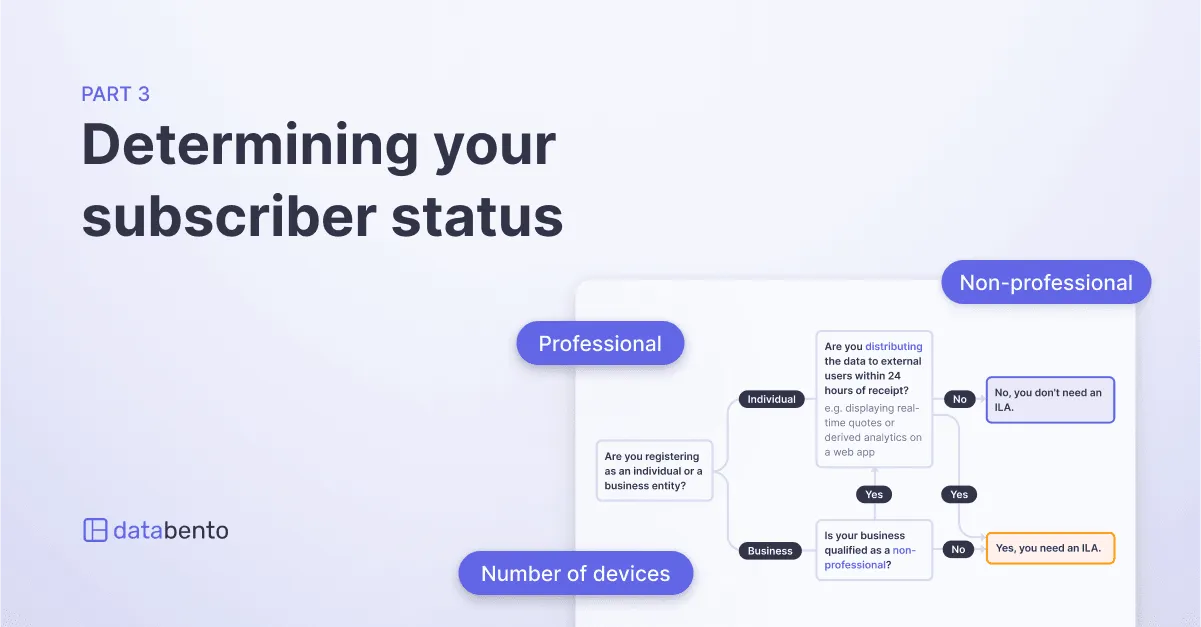Market data licensing explained FAQ part 3: how to determine your market data subscriber status
The market data licensing process is complicated. To help navigate the various fee types and definitions, we created this comprehensive FAQ to help answer your questions and walk you through the licensing process.
You can access the other articles in the series via the links below or keep reading to learn more about determining your subscriber status. Feel free to connect with us if you have any further questions.

In this section, we cover how to determine your subscriber status including display vs. non-display, and professional vs. non-professional. You can also access the other articles in the series via the links below.
3.1 What's the difference between professional or non-professional subscriber status?
3.2 What's the difference between display and non-display subscriber status?
3.3 What's the difference between internal use and redistribution?
3.4 How do I calculate the number of devices to report?
3.5 When and how do I report my device count?
Professional subscribers are typically defined as individuals or entities using market data for commercial purposes, such as trading, analytics, or product development. If you’re a financial services professional by day, while using real-time data for personal trading outside of work, some exchanges may categorize you as a professional subscriber. Professional subscriber fees are higher compared to non-professional subscriber fees. If you’re a professional subscriber, be prepared to pay at least $1576 for real-time Nasdaq equities data, $2000 for real-time OPRA options data, and $2700 for real-time CME futures data per month.
Non-professional subscribers are typically individuals who are using market data for personal, non-commercial purposes, such as personal investment decisions or educational purposes. Feel free to contact us if you still need help determining your subscriber status.
Display subscribers use market data in a way that involves presenting the information to end-users in a visible, readable, or audible format. This could include displaying market data on trading platforms, financial news websites, or any other interface where end-users can access the information directly.
Non-display subscribers use market data in ways that don't involve presenting the information directly to end-users in a visible or audible format. This could include using the data for algorithmic trading, internal analytics, or other non-public, backend applications. Non-display fees are usually higher than display fees.
Internal use refers to the subscriber's use of market data strictly within its own organization for its internal purposes. The data is not shared or disseminated to external parties.
Redistribution occurs when the subscriber disseminates or shares the market data with external parties beyond the original licensing agreement. This can include providing the data to clients, customers, or other third parties. Even if you're using a third party data provider, the exchange requires a redistribution fee. Note that some exchanges require a redistribution fee for historical data as well as real-time data.
The definition of a device can vary. It may include physical devices (e.g., computers, terminals, phones) or user IDs/accounts that access the market data. Some agreements may count devices on a concurrent usage basis, while others may count registered devices over a specific period.
Exchanges usually charge more if you're consuming market data via multiple devices.
In short: Depending on your arrangement, you'll either report directly to the exchange each month, or Databento will report on your behalf each month. There are some exchanges which allow you to report on a quarterly basis, but monthly reporting seems to be the standard.
If you report directly to the exchange, they'll usually have you register on their website for the purpose of filing the monthly report. Late reports may be subject to charges or penalties depending on the exchange.
You can access the other articles in the series via the links below. Feel free to connect with us if you have any further questions.